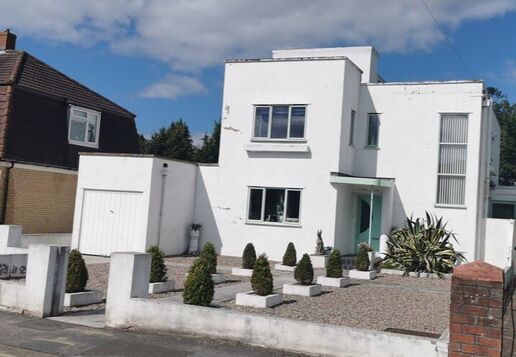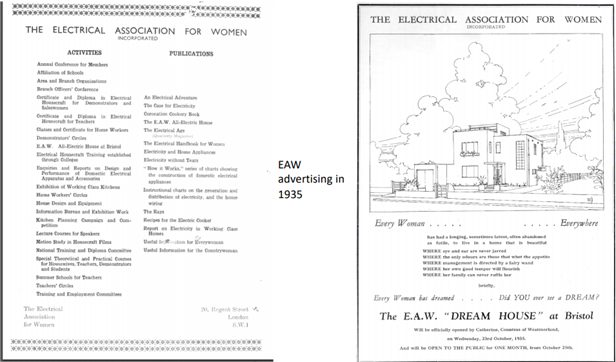The All Electric House, Bristol
 The All Electric House, Bristol in August 2020
The All Electric House, Bristol in August 2020
The All Electric House was commissioned by the Bristol Branch of the Electrical Association for Women (EAW) and built in 1935. The EAW was an International organisation which had formed in 1924 as a sister organisation to the Women’s Engineering Society (WES), and its mission was to popularise the domestic use of electricity to make the lives of women less onerous. The All Electric House was an ambitious project to demonstrate the potential of this new electrical technology, and the house featured all kinds of electrical appliances and gadgets from an electric cooker, refrigerator and fires in every room to drying cupboards, electric clocks and food warmers.
The use of electricity in the home by women was the turning point that allowed women to access careers that were previously impossible due to the time constraints of manual housework, so the work of EAW and the building of this showhome represents a significant milestone in the history of women’s empowerment. This house was instrumental in demonstrating the benefits of this new technology that was soon to be demanded by all housewives of the time.
A local architect, Adrian Powell, was chosen to design the house, and he worked closely with the EAW.
PE Gane Ltd designed the interior of the house, and this design marked a change of direction for modern Britain in which it was understood that the householder would perform domestic tasks, rather than maids and cooks.
The house is situated at 26 Withey Close West, Stoke Bishop, Bristol, BS9 3SX and the present owners have maintained the house in the style in which it was conceived, retaining many of the original features.
Permission has been given and the owner, and by the Bristol Civic Society to erect a blue plaque at the property in order to commemorate its history and significance.
Funding of £1000 is now sought to facilitate this blue plaque project.
Please get in touch to discuss further.
The use of electricity in the home by women was the turning point that allowed women to access careers that were previously impossible due to the time constraints of manual housework, so the work of EAW and the building of this showhome represents a significant milestone in the history of women’s empowerment. This house was instrumental in demonstrating the benefits of this new technology that was soon to be demanded by all housewives of the time.
A local architect, Adrian Powell, was chosen to design the house, and he worked closely with the EAW.
PE Gane Ltd designed the interior of the house, and this design marked a change of direction for modern Britain in which it was understood that the householder would perform domestic tasks, rather than maids and cooks.
The house is situated at 26 Withey Close West, Stoke Bishop, Bristol, BS9 3SX and the present owners have maintained the house in the style in which it was conceived, retaining many of the original features.
Permission has been given and the owner, and by the Bristol Civic Society to erect a blue plaque at the property in order to commemorate its history and significance.
Funding of £1000 is now sought to facilitate this blue plaque project.
Please get in touch to discuss further.
Stradling Collection ExhibitionThe All Electric House Exhibition
The Stradling Collection, Bristol October – November 2024 To commemorate the centenary of the formation of the Electrical Association for Women (EAW) in 2024, the Stradling Collection in Bristol is hosting an Exhibition to showcase Bristol’s All Electric House, a modernist domestic house built in 1935 which still stands today in Stoke Bishop. The house reflected the aims of the Electrical Association for Women which was to encourage modern women to use electricity and electrical appliances in the home, in order to ‘escape the drudgery of everyday tasks’, thus freeing up their time for more independence, and the ability to enter the workforce. This exhibition forms part of the 2024 Electric Dreams project to celebrate the ongoing role of women in energy. The house was commissioned by the EAW and designed by local architect Adrian E Powell, ARIBA. It was kitted out with furniture from another local designer Crofton Gane, who worked for PE Gane Ltd, who had been working with and influenced by the Hungarian-German architect and furniture design Marcel Breuer, who brought Bauhaus style to the UK when he came as a refugee in the mid 30s. One feature of this particular house, in addition to the novelty of the many electrical appliances that it contained, was the idea that it was the home-owner who did the cooking and cleaning, rather than paid domestic staff, and this was the start of kitchen design that saw great efficiencies of movement and ergonomic design of the kitchen. |
Blue PlaqueBristol Civic Centre have approved a Blue Plaque for the All Electric House, which will be erected at a convenient time - hopefully in 2024.
|
Further images can be seen on the Pinterest site here.
References
- The All Electric House, Stoke Bishop https://stradlingcollection.wordpress.com/2016/07/13/crofton-gane-and-the-all-electric-house/
- Crofton Gane and the All Electric House https://stradlingcollection.wordpress.com/2016/07/13/crofton-gane-and-the-all-electric-house/
- Electrifying Women, https://electrifyingwomen.org/wp-content/uploads/sites/56/2020/04/Electrifying-Women-Bristol-SCEEM-6-March-2020.pdf
- The history of the Electrical Association for Women, Magnificent Women, https://www.magnificentwomen.co.uk/eaw.html
- Institution of Engineering and Technology Library Archive, https://theiet.libertyasp.co.uk:443/library/OpacLogin?mode=BASIC&openDetail=true&corporation=IET&action=search&queryTerm=uuid%3D%228de368a6ac1001780174820e2e767f3f%22&operator=OR&url=%2Fopac%2Fsearch.do
- The Electrical Association for Women blog post https://blogs.brighton.ac.uk/womendesigning/2015/11/12/the-electrical-association-for-women/
- SSE Heritage Site, showing a photograph of the opening ceremony http://www.sseheritage.org.uk/index.asp?page=list&mwsquery=%7Bsection%7D=%7Bphotographs%7D&mwsquery=(%7Bsearch%7D=*%7BEAW%7D)&filename=CHREM&hitsStart=1
- Domesticating Modernity: The Electrical Association for Women, 1924-1986, Carroll Pursell, The British Journal for the History of Science, Vol. 32, No. 1 (Mar 1999) pp 47-67, Cambridge University Press https://www.jstor.org/stable/4027969
- Dorothy Newman, 'The EAW House, Bristol', Electrical Age for Women (1935), 2, 920.
- Newman, op. cit. (43), and 'The EAW all-electric house building at Bristol', Electrical Age for Women (1935), 2, 888.
- Newman, op. cit. (43), and The Electrical Association for Women Presents the EAW All-Electric House, London, c. 1935, 2
- https://web.archive.org/web/20160813171956/https:/sites.google.com/a/staff.westminster.ac.uk/electricity-for-women/home/the-labour-saving-home
- Modern Furniture. P.E. Gane Ltd. Newport 1936, First published by P. E. Gane (Late Trapnell and Gane) Ltd. 38a & 39 College Green, Bristol and 161-3 Commercial St, Newport. This pdf edition is published by the Ken Stradling Collection, 48 Park Row, Bristol BS1 3LH. Feb. 2020. www.stradlingcollection.org









